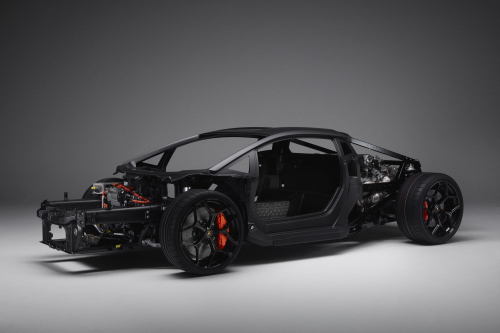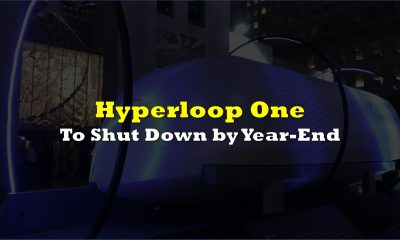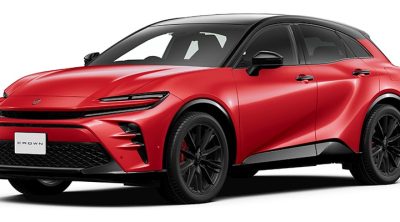Energy & Critical Metals
Lamborghini introduces new monofuselage carbon fiber monocoque concept
Lamborghini’s HPEV (High Performance Electrified Vehicle) hybrid super sports car, codenamed LB744, (earlier post) is based on a new aeronautics-inspired…

Lamborghini’s HPEV (High Performance Electrified Vehicle) hybrid super sports car, codenamed LB744, (earlier post) is based on a new aeronautics-inspired chassis, the monofuselage. As well as a monocoque made entirely of multi-technology carbon fiber, it features a front structure in Forged Composites; a special material made of short carbon fibers soaked in resin. This technology was patented and used by Lamborghini in its first structural applications as far back as 2008.
The monofuselage represents a significant step forward from the Aventador in terms of torsional stiffness, lightweight qualities and driving dynamics. The LB744 is also the first super sports car to be fitted with a 100% carbon fiber front structure. Carbon fiber is used for the front cone structures to ensure a level of energy absorption that is significantly higher when compared to a traditional metal structure—double that of the Aventador Ultimae’s aluminum front frame—combined with a substantial reduction in weight.
The LB744 monofuselage is 10% lighter than the Aventador chassis, and the front frame is 20% lighter than its aluminum predecessor. The torsional stiffness has also been improved with a value of 40,000 N·m/°, up +25% compared to the Aventador and guaranteeing best-in-class dynamic capabilities.
The design concept underlying the development of the new monofuselage is based on the maximum integration between components. This is optimized due to the introduction of extensive forged composites technology, as well as the development of the monolithic rocker ring.
This use of carbon fiber makes the LB744 unique in the super sports car arena: the single-element ring-shaped component is made of CFRP (Carbon Fiber Reinforced Plastic) and forms the supporting structure of the car. The rocker ring encloses and connects the Forged Composites elements such as the tub, the front firewall and A pillar.
The production of forged composites components also optimizes efficiency and increases sustainability during the manufacturing process by reducing the energy consumption of cooling equipment and quantity of waste materials.
The more traditional, but no less efficient, technology of autoclave composite production with pre-impregnated material was retained for the roof construction. The autoclaved carbon fiber meets high technical, aesthetic and quality requirements, complemented by craftsmanship in the highly specialized hand lay-up process, which results from years of quality-driven in-house production of composite material components. It is a manufacturing decision that also gives the customer maximum versatility in roof customization.
The rear chassis is made of high-strength aluminum alloys and features two important hollow castings in the rear dome area: these integrate the rear suspension’s shock towers and powertrain suspension into a single component with closed inertia profile, guaranteeing a significant reduction in weight, an increase in rigidity and a substantial reduction in welding lines.
Lamborghini says that the LB744 represents a new “year zero” in relation to the use of carbon fiber in car production, summed up in the acronym AIM (Automation, Integration, Modularity). ‘Automation’ refers to the introduction of automated and digitalized processes into material transformation, while preserving traditional Lamborghini manufacturing, such as in the discipline of composites.
‘Integration’ relates to the integration of several functions into a single component through the development of compression molding. This process uses preheated polymers to enable the production of components with a wide range of lengths, thicknesses and complexity, ensuring optimum integration between components to guarantee high torsional stiffness. Finally, ‘Modularity’ refers to making the applied technologies modular and therefore more flexible and efficient to respond to all the product requirements and characteristics.

Uranium Exploration Company Announces Additional Staking in the Athabasca Basin
Source: Streetwise Reports 12/22/2023
Skyharbour Resources Ltd. announced an update from its Canada-based Falcon Project along with additional…
Tesla Launches New Mega Factory Project In Shanghai, Designed To Manufacture 10,000 Megapacks Per Year
Tesla Launches New Mega Factory Project In Shanghai, Designed To Manufacture 10,000 Megapacks Per Year
Tesla has launched a new mega factory…
Giving thanks and taking stock after “a remarkable year”
An end-of-year thank you to our readers, industry colleagues and advertisers before Electric Autonomy breaks from publishing until Jan. 2
The post Giving…











